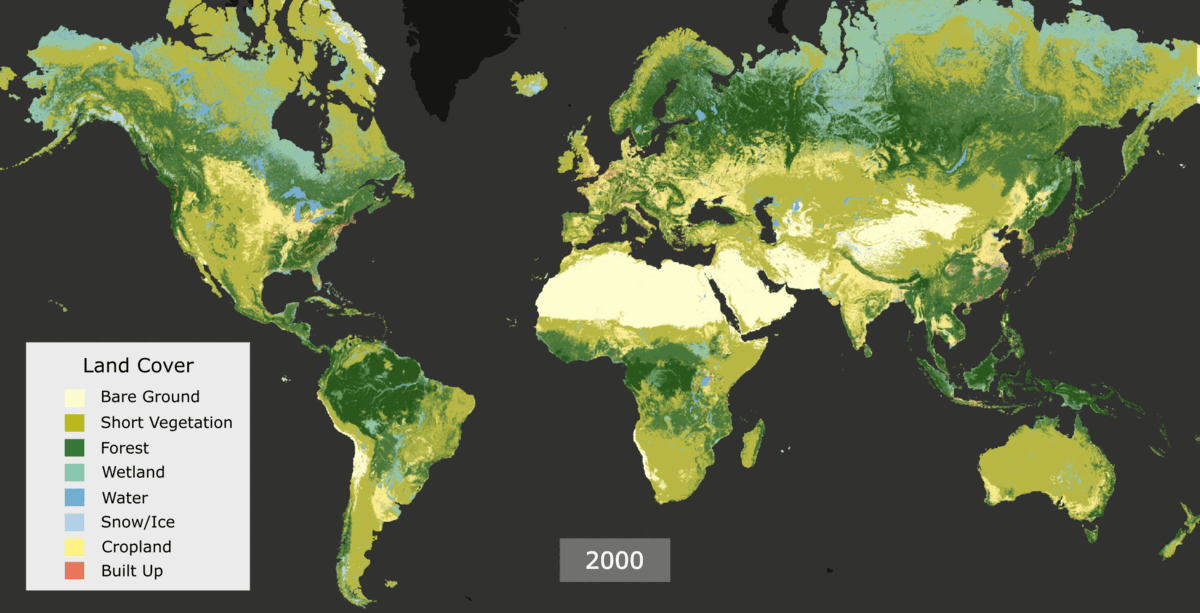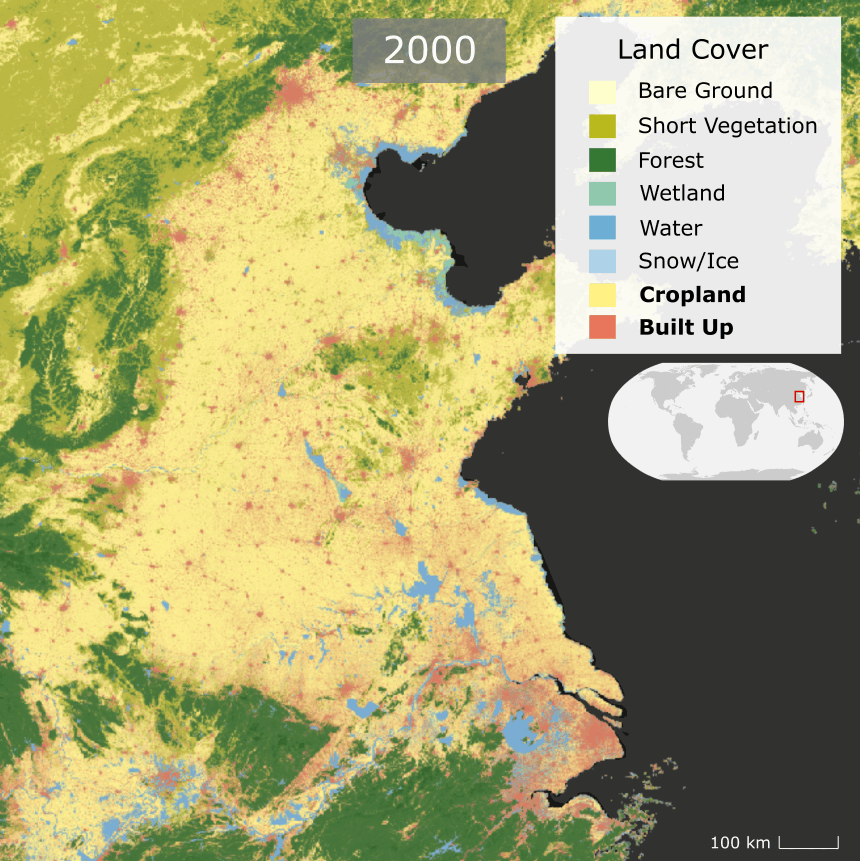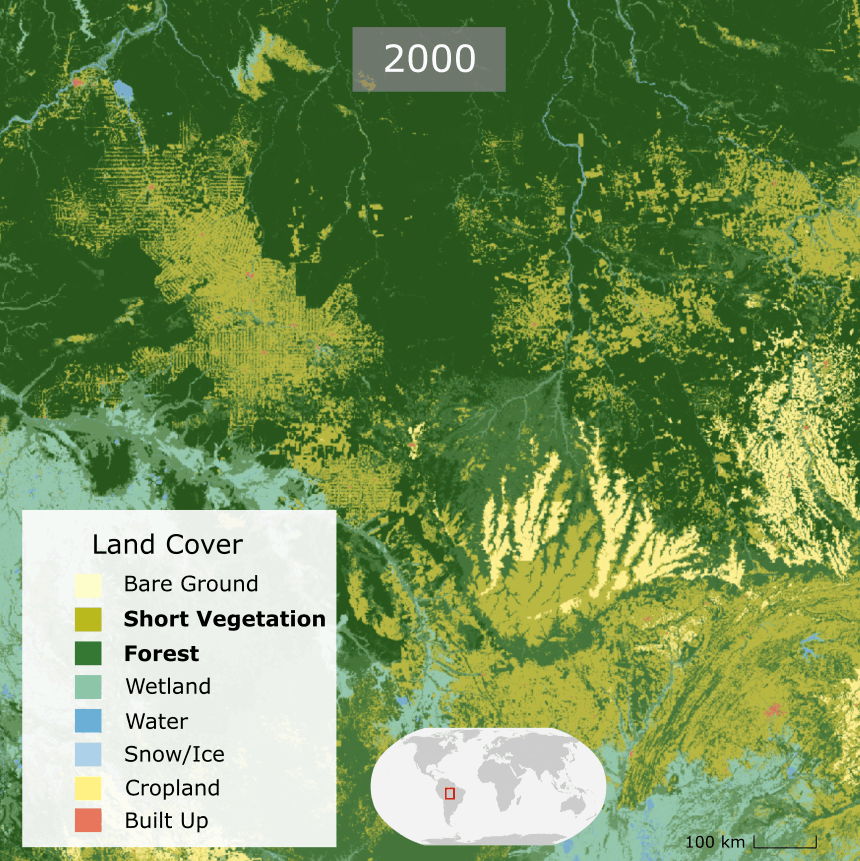20 Years of Land Cover Data Reveals Important Transformations of Our Planet
Understanding changes in land cover is essential to understanding the global land squeeze — the increasing competition over finite land and water resources to meet needs for people and nature. At a global scale, land cover changes can seem small and gradual, but these continuing changes can have big impacts for climate, nature and people.
A recent data set developed by the University of Maryland GLAD Lab and available through WRI’s Land & Carbon Lab provides the most detailed look yet at how land cover has changed over 20 years at global, national, regional and local scales.
The data shows that between 2000 and 2020, 6% of the world’s land surface (801 million hectares) has changed. While this may seem like a small amount, it is an area equivalent to the size of the continental United States. Zooming in to the places where competition for land is greatest reveals a myriad of land cover changes — from cropland to urban areas, forest to grassland, grassland to cropland and more — often with the result of expanding human land uses into natural ecosystems.
While a 6% change in global land cover over 20 years may seem small, the recent data from Land & Carbon Lab allows us to see what these changes are and where they occurred in higher resolution than ever before.
Here are four examples of key changes that have occurred over roughly a single generation that may seem small but have important implications for our collective future.
1. Cities have replaced millions of hectares of grasslands and croplands in China
Urbanization and the expansion of cities is a major contributor to land transformation worldwide. From 2000 to 2020, urbanized areas increased globally by 50%. In China alone, 88 million hectares (Mha) of land — an area roughly the size of Tanzania — was converted to urbanized areas, largely from grasslands and croplands.
Expanding urbanization can have implications for climate change since cities currently account for over 70% of global CO2 emissions. Less vegetation and more paved surfaces also contribute to urban heat islands, leading to higher energy use for air conditioning. Urbanization is also a main driver of increased meat consumption, which is a major contributor to emissions. Additionally, paving over productive croplands often means that more croplands need to be developed elsewhere, likely causing further conversion from other land types, which in turn may have further effects for climate change and natural ecosystems.
Continued outward growth of urbanized areas as we’ve seen over the last 20 years may contribute to the challenge of meeting emissions reduction goals needed to mitigate climate change, making promising work to make cities more sustainable all the more important.
2. Forests were converted to pasture in South America
Another important driver of land conversion is expanding agricultural land, including pasture for livestock. The main cause of this expansion is an increase in meat production, which has tripled worldwide over the last 50 years due in part to rising incomes and urbanization. South America is home to some of the Earth’s most important forests, yet from 2000-2020, 40 Mha of forests were converted to short vegetation — much of which is pasture in this example.
Agriculture and related land use change account for one-quarter of the world’s annual greenhouse gas (GHG) emissions, with livestock being the most resource-intensive agricultural commodity. In fact, pasture for cattle ranching replaced more forest than any other commodity in 2001-2015 and was responsible for 16% of the total global tree cover loss during that period.
Pasture expansion has a triple impact for climate change: it results in GHG emissions from deforestation when forests are cleared for pastureland, followed by an increase in GHG emissions from farming activities including cattle belching and use of fertilizers, and results in the loss of future carbon removals that would have been provided by standing forests. Further, the global growth in demand for ruminant meat like beef is projected to continue to increase, growing by 88% by 2050 from 2010 levels.
So while the conversion to pasture in some regions of South America may not look like a lot of change, the impacts for climate change are already compounded, and this conversion is only projected to grow.
3. Glaciers, snow and ice are melting at high altitudes
When we think of melting glaciers, we often think of large ice sheets at the poles and loss of ecosystems for iconic animals like polar bears. But it’s not just a problem for polar bears. Melting of snow and ice in regions outside of the poles is happening close to where people live. For example, over the last 20 years, high-altitude regions of Africa, North America and Asia lost over 4 Mha of permanent snow and ice.
Glaciers and permanent snow and ice in regions outside of the poles — areas that are high-altitude but low- and mid-latitudes — constitute a small amount of land. But these are areas where small changes in land cover are leading to outsized impacts.
Glaciers, snow and ice in the low- and mid-latitudes are sensitive to the effects of climate change, including warming temperatures. Melting in these areas is resulting in loss of irreplaceable historical climate records contained in the ice. Yet there are more immediate and worrying risks as well: accelerating and unpredictable melting can pose an imminent threat to local communities’ agricultural and cultural resources and can threaten safety and food, water and energy security, such as for the more than 1 billion people who depend on consistent snow and glacial melt from the Himalayan region.
4. Land cover changes are affecting the benefits of protected areas
Protected areas — places set aside for conservation and sustainable use — can offer a way to safeguard nature and cultural resources, but only if they are managed effectively. Land cover changes, particularly conversion for human use, can diminish the benefits of protected areas. From 2000-2020, there was 79 Mha of land cover change within protected areas, including both natural and human-caused conversion.
Across the world there are more than 270,000 protected areas. Protected areas guard critical habitat and have greater biodiversity than other areas; they positively affect food, water and the climate; and they provide economic benefits and cultural resources to communities.
Land conversion in protected areas, if not well managed, can have a variety of negative effects for people and nature: it can degrade ecosystem services, destabilize land and climate dynamics, and damage human health and cultural services. Recent commitments have expanded the areas under protection worldwide — in fact, nearly 17% of the Earth’s land and inland waters are now protected, meeting international targets. But to be effective, the quality of these areas needs to improve, meaning seemingly small amounts of land conversion can take away from the benefits that protected areas provide.
Data makes it possible to track change and develop solutions
These examples illustrate that changes are happening around the globe on a seemingly slow but steady pace, resulting in large localized changes that can have substantial impacts. Using cutting edge geospatial data to zoom in to different regions reveals these changing land dynamics and shows how the global land squeeze is playing out locally where people, nature and climate intersect — and conflict. Better understanding these dynamics is a first step to developing better, regionally- and situationally-specific solutions to produce, protect, reduce and restore.
Cover image: European Space Agency, Mount Everest for International Mountain Day, Flickr (CC BY-SA 2.0)




